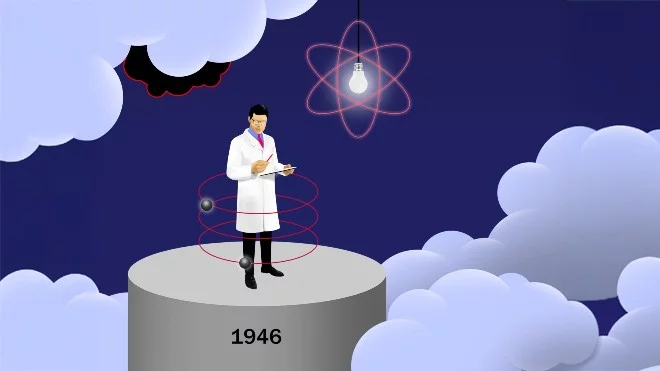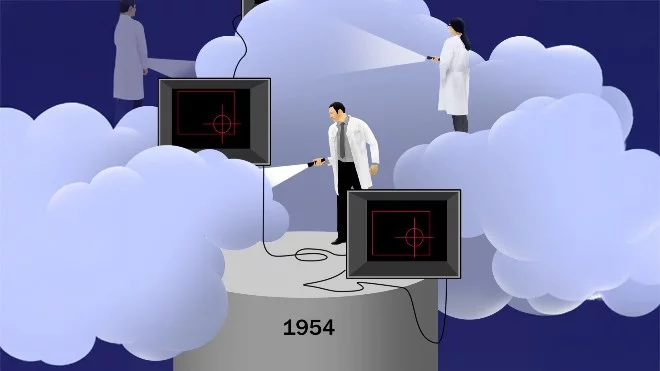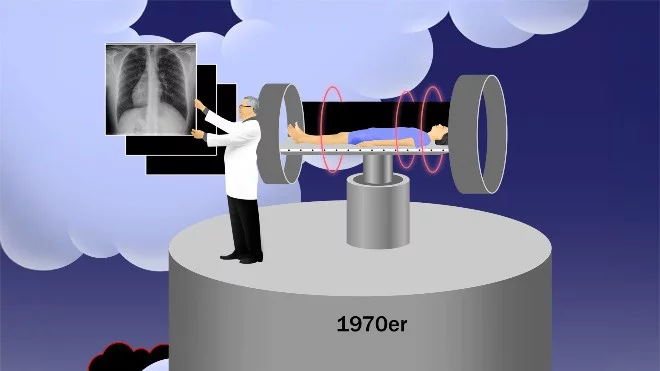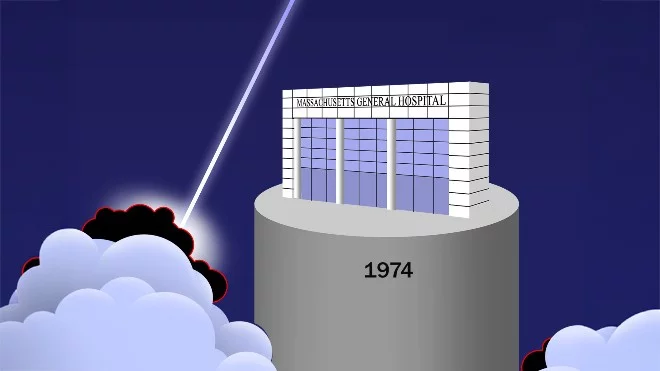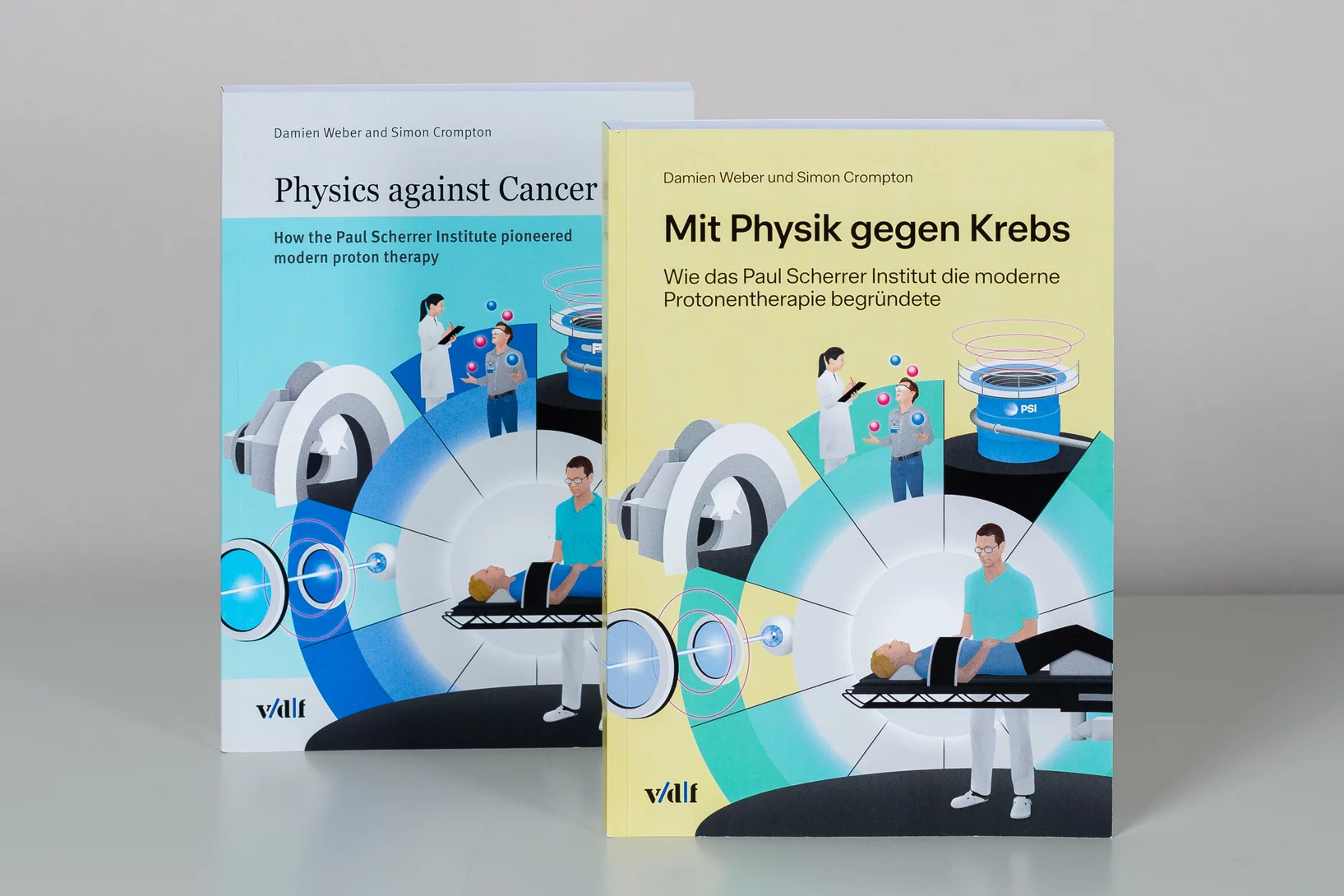High tech against cancer
At the Center for Proton Therapy patients are treated gently and efficiently using a procedure developed at PSI: Proton therapy uses the energy of protons to destroy cancer cells.
What are protons?
Protons are one of the building blocks of atoms. All matter surrounding us is made up of atoms. Their nuclei comprise varying numbers of positively charged protons and neutrons with a neutral electric charge. Surrounding the nucleus is an atomic shell consisting of negatively charged electrons. Like all particles with an electric charge, protons can be directed, bundled and formed into a beam using a magnetic field.
A brief journey through time:
Over seventy years have passed from the initial concept to its modern-day successful realisation. Decades of research and sophisticated technological developments have made PSI’s Center for Proton Therapy CPT one of the world’s foremost research and therapy centres for the targeted treatment of tumours using protons.
1946
The American physicist Robert R. Wilson is shocked by the devastation caused by the atomic bomb, a weapon whose development he contributed to. As a result, he now champions the peaceful use of nuclear energy. He is the first scientist to propose a method of cancer treatment using charged particles, specifically protons.
Bragg-Peak
Wilson’s concept is based on the work of William Henry Bragg some 40 years earlier. Bragg had shown that when protons move through matter, they release their maximum energy immediately before they come to a standstill. Unlike photons –i.e. conventional X rays– protons are therefore able to deliver the highest radiation dose directly to the tumour. This means minimal damage to the healthy tissue in front of the tumour, and no damage at all to the tissue behind it.
1954
Some years later, the first clinical studies start in the US on the therapeutic use of particle radiation. However, hormone-active tumours of the pituitary gland are treated first, as diagnostic imaging is still in its early stages and other tumours cannot be localised with enough precision using the methods of the time.
1970s
The development of diagnostic imaging, such as the advent of computer tomography, as well as advances made in computer-supported radiotherapy, allow malignant tumours to be treated with particle radiation for the first time.
1974
In 1974 medics at Massachusetts General Hospital (Boston, US) treat a patient’s malignant tumour with proton therapy for the very first time.
1980
One of PSI’s existing proton accelerators, operational since 1974, enables a team of dedicated medics, physicists and technicians to develop a high-precision method for treating tumours using protons.
Research institutes
Proton therapy centres tend to evolve from research institutes as a rule: to realise such a highly complex method requires knowledge and skills from basic research, together with the type of large research facilities in place at PSI and comparable scientific institutes.
1984
Proton therapy has been used at PSI since 1984 to treat patients suffering from eye tumours with the help of OPTIS, a dedicated ocular treatment facility.
1996
Gantry 1 comes into service at PSI. It is the first facility worldwide for treating patients in routine clinical operation using the spot-scanning technique developed at PSI. This technique allows the proton beam to be directed so precisely that the spot where the protons release their maximum energy dose is located at the exact desired position in the tumour. By superimposing many single spots, the tumour can be uniformly treated with the required radiation dose. This allows for extremely accurate, homogeneous radiation treatment that can be tailored optimally to the often irregular tumour shapes. Spot-scanning is sometimes also called pencil-beam scanning, as the beam is about as thin as a pencil.
1998
Successes in treating eye tumours and international interest in the spot-scanning technique induce PSI to define strategies for developing proton therapy further. A decision is taken to expand research and development and increase the treatment of patients at PSI using proton therapy.
2007
Proton therapy at PSI gets its own ring accelerator. Until now, the protons have been provided by PSI’s large proton accelerator. However, this is used mainly for research purposes and is out of service each year for several weeks due to maintenance. The new compact superconducting accelerator allows patients to be treated all year round.
2013
Work on the further development of Gantry 1 leads to the construction of a new radiation facility, Gantry 2, with more advanced features. In November 2013, the first patient is treated at Gantry 2.
2018
Gantry 3, a further state-of-the-art treatment unit, comes into service. It was realised as a research partnership with a commercial provider. Technically Gantry 3 offers treatment options comparable to Gantry 2. At the end of 2018, Gantry 1 is withdrawn from clinical use after successfully treating over 1,300 patients. It is still in use for research purposes.
How the Gantry works
The treatment units at the Center for Proton Therapy at PSI allow radiation to be directed at tumours from any direction. For this purpose the Gantry’s radiation head can be turned around the patient. A Gantry weighs over 200 tonnes. A large number of magnets precisely directs the proton beam to the right position.
Proton acceleration
Protons are extracted from the ion source within in the ring accelerator. Here hydrogen atoms are continuously split into electrons and protons. After the protons have completed a circular path 630 times, they are directed into the beam path, where they are bundled together with the help of magnets. The protons then travel through the 50 metres long beam path at two thirds the speed of light to one of the treatment units, where they are precisely directed at the tumour.
Today
The spot-scanning technique developed at PSI has established itself worldwide as the leading technology for proton therapy and is constantly being further developed at PSI. The goal is to increase the speed of treatment while also increasing precision. The close link between technological development and clinical use sets PSI apart from a hospital or an industrial manufacturer. On the clinical side, PSI participates in several international studies. The aim is to expand the scope of treatment to enable also cancer patients with indications not currently approved in Switzerland to profit from the benefits of proton therapy.
The number of centres worldwide offering spot-scanning proton therapy continues to grow steadily from about 90 in 2020 and that figure is expected to be double by 2030. Thus, more and more patients across the globe are able to benefit from this extremely precise and gentle radiation technique.
